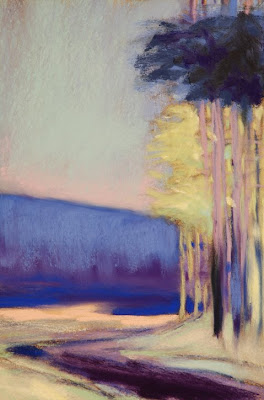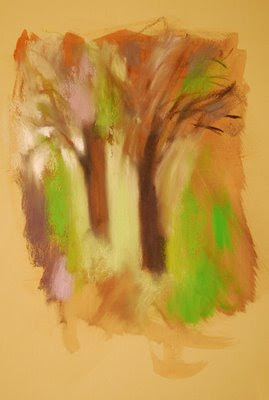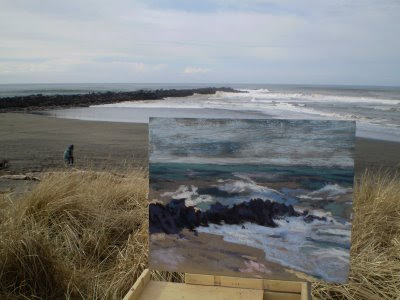Occasionally I get questions from my readers, and I answer all of them. The questions that I received from a Canadian reader this week were specific enough that I think it worth sharing my answers.
From Patricia Vesely:
Hi CaseyI am an avid fan of your website - each painting posted is more awesome than the last! I am also impressed by the professionalism and the organization of your blog.The information I have noted there is very valuable to me, being a relative newcomer to pastels and having not done anything artsy for years. Now I must purchase new pastel colors - I wonder if you could post the names of some of the Experimental Colors?I like the way you are able to switch, for instance, from a somber palette one painting (Tree on a rock Bed) to a more intense/vibrant palette like WK's pinks and greens.Do you select a palette before beginning then stick to those particular colors, or do you select them as you go along?Thanks for all you share.pv
Now I must purchase new pastel colors - I wonder if you could post the names of some of the Experimental Colors?I like the way you are able to switch, for instance, from a somber palette one painting (Tree on a rock Bed) to a more intense/vibrant palette like WK's pinks and greens.Do you select a palette before beginning then stick to those particular colors, or do you select them as you go along?Thanks for all you share.pv
Thanks for the kind comments, Patricia, and also for the questions.
hard pastels to begin with...
I would say that one should not overlook getting a set of hard pastels to begin with. They can and do contain vibrant, intense colors, and also the muted earth tones you'll want for some paintings. Not to mention that they are easier to work with.
That being said, we all desire the luscious soft pastels and could blow $10,000 on them and still not have all the available ones on the market! To solve that problem, get hold of the Multi-Brand Color Chart, from the publisher Huechroval.
...then buy open stock
Using this book will help prevent expensive redundant buying, which can happen when you buy pastel sets and find that some sticks are repeats. I would say to target wisely the set that you want to get started with, and then buy open stock, using a color chart for a guide. I also keep a file of each brand of pastel that I use, with either a printed proprietary color chart, or a hand made one which I get from Dakota Pastels.
Now, to the specifics of which pastels I use. Here is the image, again.

I recall using hard pastels to indicate the tree trunks, the muted ultramarine of the sky, and the muted yellows in the tree canopy that is behind. The brand I favor is Sakura, which isn't available anymore in the US. Lucky you, Patricia, because I think all of the Commonwealth nations do have these yummy hard pastels available. They are Japanese made, and I particularly like the way they are embossed with numbers for easy reference.
the grand champions of intense pinks
While on the sky, the pink is by Sennelier, who are the grand champions of intense pinks.
All of the darks are from my favorite maker, Diane Townsend. I would say most of the other colors, including the intense blue of the mid ground, are DTs.
The pale greens in the tree foliage remind me of the buttery soft Schmincke brand. Probably if I were to repeat this image, that's what I would reach for here.
There I was...
As for the process and selecting my palette, I recall that this painting was formulated during one of those wakeful nights where I was thinking of art at bedtime. The picture of bright trees behind was invented this way, and I recall wanting them to be high key yellow-greens. The perfect compliment (in my opinion) to the greens is pink, and the compliment that speaks to me for yellow is ultramarine blue. Of course, the theoretical compliment to yellow is violet, but my eye wanted blue.
There I was, with a violet background set of hills, and it wasn't right. Did I reach for a hue for resolution? No - that's not my method. I prefer the color attribute of intensity above all else. And, when addressing my palette, I keep a mental checklist of which sticks present which intensity. The blue that I chose for this job is a jumbo Sennelier - the only stick that would make this mark and the first one that I think of for intense blues.
selection, then resolution
I am afraid to say that for that stick, you would need a time machine, for the French proprietors, in their infinite wisdom, have discontinued that size. They do offer the "La Grande" size, but the experience isn't the same and neither are the marks.
In review, the palette selection is an idea for one, then two and often three colors in a composition, but then resolution always becomes a major factor in completing a work. The decisions are responses and they are often based on criteria that is surprising, such as the brand and the behavior of a particular stick.
For more posts on pastel brands, see my label, Pastel Brands Review.























